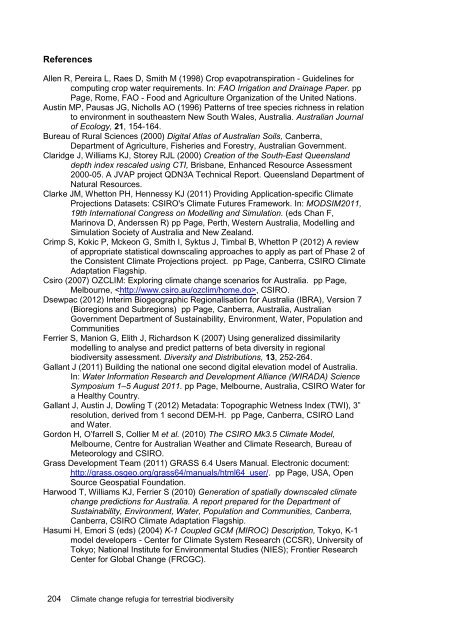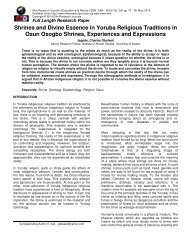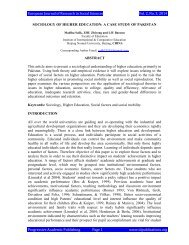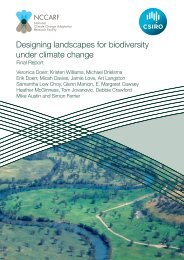Williams-Climate-change-refugia-for-terrestrial-biodiversity_0
Williams-Climate-change-refugia-for-terrestrial-biodiversity_0
Williams-Climate-change-refugia-for-terrestrial-biodiversity_0
You also want an ePaper? Increase the reach of your titles
YUMPU automatically turns print PDFs into web optimized ePapers that Google loves.
References<br />
Allen R, Pereira L, Raes D, Smith M (1998) Crop evapotranspiration - Guidelines <strong>for</strong><br />
computing crop water requirements. In: FAO Irrigation and Drainage Paper. pp<br />
Page, Rome, FAO - Food and Agriculture Organization of the United Nations.<br />
Austin MP, Pausas JG, Nicholls AO (1996) Patterns of tree species richness in relation<br />
to environment in southeastern New South Wales, Australia. Australian Journal<br />
of Ecology, 21, 154-164.<br />
Bureau of Rural Sciences (2000) Digital Atlas of Australian Soils, Canberra,<br />
Department of Agriculture, Fisheries and Forestry, Australian Government.<br />
Claridge J, <strong>Williams</strong> KJ, Storey RJL (2000) Creation of the South-East Queensland<br />
depth index rescaled using CTI, Brisbane, Enhanced Resource Assessment<br />
2000-05. A JVAP project QDN3A Technical Report. Queensland Department of<br />
Natural Resources.<br />
Clarke JM, Whetton PH, Hennessy KJ (2011) Providing Application-specific <strong>Climate</strong><br />
Projections Datasets: CSIRO's <strong>Climate</strong> Futures Framework. In: MODSIM2011,<br />
19th International Congress on Modelling and Simulation. (eds Chan F,<br />
Marinova D, Anderssen R) pp Page, Perth, Western Australia, Modelling and<br />
Simulation Society of Australia and New Zealand.<br />
Crimp S, Kokic P, Mckeon G, Smith I, Syktus J, Timbal B, Whetton P (2012) A review<br />
of appropriate statistical downscaling approaches to apply as part of Phase 2 of<br />
the Consistent <strong>Climate</strong> Projections project. pp Page, Canberra, CSIRO <strong>Climate</strong><br />
Adaptation Flagship.<br />
Csiro (2007) OZCLIM: Exploring climate <strong>change</strong> scenarios <strong>for</strong> Australia. pp Page,<br />
Melbourne, , CSIRO.<br />
Dsewpac (2012) Interim Biogeographic Regionalisation <strong>for</strong> Australia (IBRA), Version 7<br />
(Bioregions and Subregions) pp Page, Canberra, Australia, Australian<br />
Government Department of Sustainability, Environment, Water, Population and<br />
Communities<br />
Ferrier S, Manion G, Elith J, Richardson K (2007) Using generalized dissimilarity<br />
modelling to analyse and predict patterns of beta diversity in regional<br />
<strong>biodiversity</strong> assessment. Diversity and Distributions, 13, 252-264.<br />
Gallant J (2011) Building the national one second digital elevation model of Australia.<br />
In: Water In<strong>for</strong>mation Research and Development Alliance (WIRADA) Science<br />
Symposium 1–5 August 2011. pp Page, Melbourne, Australia, CSIRO Water <strong>for</strong><br />
a Healthy Country.<br />
Gallant J, Austin J, Dowling T (2012) Metadata: Topographic Wetness Index (TWI), 3”<br />
resolution, derived from 1 second DEM-H. pp Page, Canberra, CSIRO Land<br />
and Water.<br />
Gordon H, O’farrell S, Collier M et al. (2010) The CSIRO Mk3.5 <strong>Climate</strong> Model,<br />
Melbourne, Centre <strong>for</strong> Australian Weather and <strong>Climate</strong> Research, Bureau of<br />
Meteorology and CSIRO.<br />
Grass Development Team (2011) GRASS 6.4 Users Manual. Electronic document:<br />
http://grass.osgeo.org/grass64/manuals/html64_user/. pp Page, USA, Open<br />
Source Geospatial Foundation.<br />
Harwood T, <strong>Williams</strong> KJ, Ferrier S (2010) Generation of spatially downscaled climate<br />
<strong>change</strong> predictions <strong>for</strong> Australia. A report prepared <strong>for</strong> the Department of<br />
Sustainability, Environment, Water, Population and Communities, Canberra,<br />
Canberra, CSIRO <strong>Climate</strong> Adaptation Flagship.<br />
Hasumi H, Emori S (eds) (2004) K-1 Coupled GCM (MIROC) Description, Tokyo, K-1<br />
model developers - Center <strong>for</strong> <strong>Climate</strong> System Research (CCSR), University of<br />
Tokyo; National Institute <strong>for</strong> Environmental Studies (NIES); Frontier Research<br />
Center <strong>for</strong> Global Change (FRCGC).<br />
204 <strong>Climate</strong> <strong>change</strong> <strong>refugia</strong> <strong>for</strong> <strong>terrestrial</strong> <strong>biodiversity</strong>






